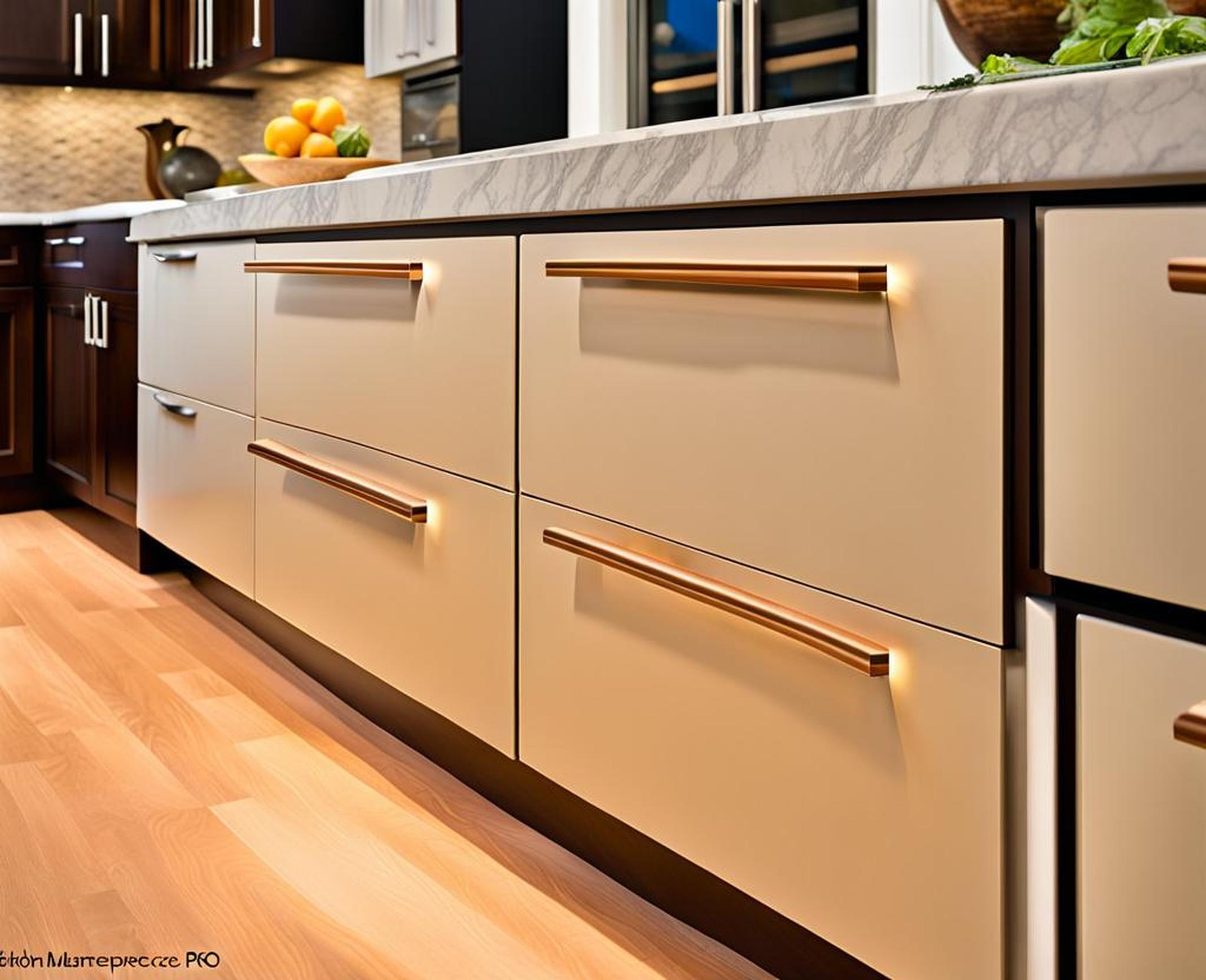Having handles properly positioned on kitchen cabinets makes a world of difference in both form and function. Carefully placing handles allows for easy access into storage spaces while also contributing to a streamlined aesthetic. Follow these comprehensive handle placement guidelines to maximize usability and achieve a cohesive look.
When installing new handles or repositioning existing ones, keep the end user in mind. Factors like average height and mobility are important considerations. Additionally, think about specific cabinet contents and location within the kitchen workspace. With strategic handle placement, you can create a kitchen that is tailor-made to suit your needs.

Where to Place Handles on Cabinet Doors
For standard cabinet doors, guidelines recommend positioning handles directly opposite of the hinges, 2-1/2″ to 3″ up from the bottom corner. The 36″-48″ height range from the floor provides comfortable ergonomics for the average user. However, make adjustments as needed based on height or accessibility requirements.
Installing handles in this location provides ideal leverage for opening doors. Hands can easily grip under the handle to pull doors open. Keeping handles a sufficient distance from the bottom also reduces the chance of knocking into lower handles when walking near the cabinets.
Door Clearances
When marking locations for handle installation, pay attention to spacing needs. Leave adequate clearance between the handle edge and adjacent cabinet doors or hinges. About 1/8″ of space allows fingers to comfortably grip the handle without obstruction. This spacing also prevents handles from scraping against each other or cabinet surfaces.
Handle Positioning by Cabinet Function
Consider the contents of each cabinet when fine-tuning individual handle placement. For example, on cabinets housing dishes, glasses, and other frequently accessed items, positioning handles slightly closer to the front edge quickens access. On the other hand, less utilized cabinets containing things like cleaning supplies may have their handles moved back farther from the front edge or positioned higher up.
Adjusting for Specific Locations
Make ergonomic tweaks to handle placement based on the cabinet’s proximity to busy work areas. Raise handles higher on upper cabinets located right above the sink or cooktop. This reduces accidental contact when hands are wet or handling hot items. An extra inch of clearance helps prevent painful burns.
Optimal Handle Placement on Drawers
Approaches for handle placement on drawers allows for a few more options. For narrower drawers, a single centered handle is best. Wide drawers look more balanced with two handles placed equidistant from the outer edges. Allow a minimum of 2″ clearance below drawer handles to open them without obstruction.
When installing multiple handles per drawer, make sure spacing looks proportionate to the drawer size. Mismatched handle pairs can create visual imbalance. Typically, an even amount of space between individual handles and the edges is ideal. However, personal taste can dictate placement too.
| Drawer Width | Recommended Handle Layout |
| Up to 20″ | Single handle centered |
| 20″ – 36″ | Two handles spaced evenly |
| 36″ – 48″ | Three handles spaced evenly |
Achieving Visually Pleasing Handle Placement
With good handle placement, kitchen cabinets transform from purely functional to decorative elements. For the most pleasing aesthetic, maintain consistent alignment between handles on the same cabinet unit. A row of evenly spaced handles has greater visual impact than haphazard spacing.
Also think about how the handle design interacts with the cabinet style and finish. Opt for handles that integrate well into the overall kitchen decor. For example, delicate glass knobs suit a light, airy space better than chunky iron pulls.
Balanced Kitchen Aesthetic
When planning kitchen-wide handle placement, consider the total picture. Keeping handles on matching cabinet types aligned at the same height creates balance. Maintain this consistency across upper and lower cabinets for a harmonious arrangement. Minor adjustments to accommodate users or functions are still permitted without disrupting flow.
Drilling Precise Holes for Installation
With careful handle placement mapped out, prep cabinets for installation. When drilling holes, take steps to prevent unsightly cracks and splintering on cabinet surfaces:
- Use a drill bit slightly smaller than handle screws
- Clamp scrap wood behind drill points as a backer
- Drill pilot holes first before running screws
These precautions produce clean, neat holes the exact diameter of screws. Handles can then properly conceal openings. Position clip-on handles over holes drilled following the guidelines above.
The key to handle placement is finding the ideal balance point between form and function. When handles are thoughtfully positioned, cabinets transform from passive storage to an actively accessible and aesthetically pleasing component of a kitchen’s design. Keeping ergonomics, visual continuity, and practicality in mind results in a handle layout tailored to your needs.
You can install handles to open cabinets with ease with these guidelines. Proper planning and precise execution result in handles that cater to users of all heights and abilities. Your dream kitchen with handles placed for 100% functionality is within reach by following the placement insights above.
